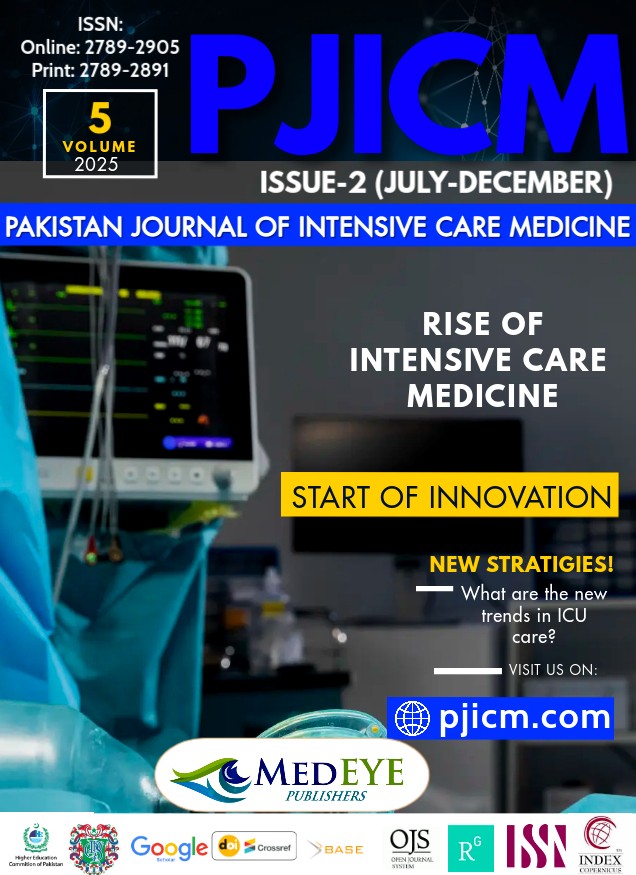OUTCOMES OF PERCUTANEOUS REVASCULARIZATION VERSUS OPTIMAL MEDICAL THERAPY FOR ISCHEMIC LEFT VENTRICULAR DYSFUNCTION
DOI:
https://doi.org/10.54112/pjicm.v5i02.193Keywords:
Ischemic Left Ventricular Dysfunction; Percutaneous Coronary Intervention; Optimal Medical Therapy; Myocardial Viability; Major Adverse Cardiovascular EventsAbstract
Background: Ischemic left ventricular dysfunction (ILVD) remains a leading cause of morbidity and mortality worldwide. The optimal management strategy—percutaneous coronary intervention (PCI) versus optimal medical therapy (OMT), is still debated, particularly in populations with limited access to advanced cardiac interventions. Objective: To compare the clinical, echocardiographic, and functional outcomes of PCI versus OMT in patients with ILVD in a tertiary care setting in Pakistan. Study Design: Prospective comparative cohort study. Setting: Department of Cardiology, Ch Pervaiz Elahi Institute of Cardiology, Multan, Pakistan. Duration of Study: January 2024 to January 2025. Methods: Sixty patients with angiographically confirmed ILVD (LVEF ≤35%) were enrolled and divided into two equal groups: PCI (n=30) and OMT (n=30), following multidisciplinary Heart Team evaluation and shared decision-making. All received guideline-directed medical therapy; PCI patients additionally underwent drug-eluting stent implantation. The primary endpoint was the 6-month incidence of major adverse cardiovascular events (MACE: all-cause death, non-fatal myocardial infarction, or heart-failure hospitalization). Secondary outcomes included changes in left ventricular ejection fraction (LVEF), New York Heart Association (NYHA) class, Kansas City Cardiomyopathy Questionnaire (KCCQ) score, and NT-proBNP levels. Statistical analyses included relative risk (RR) estimation and Cox regression modeling, with p < 0.05 considered significant. Results: The mean participant age was 59.2 ± 9.8 years; 76.7% were male, and 61.7% had diabetes. At 6 months, MACE occurred in 13.3% of the PCI group versus 40.0% in the OMT group (RR = 0.33; 95% CI: 0.12–0.92; p = 0.02). Heart-failure hospitalizations were also lower in the PCI group (20.0% vs 50.0%; p = 0.01). PCI led to greater improvements in LVEF (+7.8% vs +2.1%; p < 0.001), NYHA class (70% vs 40% improved; p = 0.02), and KCCQ score (+15.2 ± 11.7 vs +6.0 ± 9.3; p = 0.004). Multivariable analysis identified PCI as an independent predictor of reduced MACE (HR = 0.41; 95% CI: 0.18–0.92; p = 0.03). The benefit was more pronounced among patients with myocardial viability. No significant differences were found in major bleeding, stroke, or acute kidney injury between groups. Conclusion: In patients with ischemic left ventricular dysfunction, PCI was associated with a significantly lower incidence of cardiovascular events and improved functional recovery compared with OMT alone, without increased procedural risk. These findings support the role of revascularization in appropriately selected ILVD patients, particularly when guided by myocardial viability assessment. Larger multicenter trials with extended follow-up are warranted to confirm these outcomes in South Asian populations.
References
Guo L., Meng S., Lv H., Zhong L., Wu J., Ding H.et al.. Long-term outcomes of successful recanalization compared with optimal medical therapy for coronary chronic total occlusions in patients with and without left ventricular systolic dysfunction. Frontiers in Cardiovascular Medicine 2021;8. https://doi.org/10.3389/fcvm.2021.654730
Perera D., Clayton T., O'Kane P., Greenwood J., Weerackody R., Ryan M.et al.. Percutaneous revascularization for ischemic left ventricular dysfunction. New England Journal of Medicine 2022;387(15):1351-1360. https://doi.org/10.1056/nejmoa2206606
Truong V., Ngo T., Duong H., Patel V., Dai P., Ahmad M.et al.. Abstract 16558: revascularization in patients with ischemic cardiomyopathy and viability: a meta-analysis of randomized controlled trials. Circulation 2023;148(Suppl_1). https://doi.org/10.1161/circ.148.suppl_1.16558
Liga R., Colli A., Taggart D., BODEN W., & Caterina R. Myocardial revascularization in patients with ischemic cardiomyopathy: for whom and how. Journal of the American Heart Association 2023;12(6). https://doi.org/10.1161/jaha.122.026943
Kalathil R., Balakrishna A., Pusapati S., & Aboeata A. Abstract 19028: revascularization in ischemic cardiomyopathy with left ventricular systolic dysfunction- percutaneous intervention (PCI) vs medical therapy. Circulation 2023;148(Suppl_1). https://doi.org/10.1161/circ.148.suppl_1.19028
Perera D., Ryan M., Morgan H., Greenwood J., Petrie M., Dodd M.et al.. Viability and outcomes with revascularization or medical therapy in ischemic ventricular dysfunction. Jama Cardiology 2023;8(12):1154. https://doi.org/10.1001/jamacardio.2023.3803
Ezad S., Ryan M., & Perera D.. Can percutaneous coronary intervention revive a failing heart?. Heart International 2022;16(2):72. https://doi.org/10.17925/hi.2022.16.2.72
Acerbo V., Cesaro A., Scherillo G., Signore G., Rotolo F., Michele G.et al. Understanding the role of coronary artery revascularization in patients with left ventricular dysfunction and multivessel disease. Heart Failure Reviews 2023;28(6):1325-1334. https://doi.org/10.1007/s10741-023-10335-0
Mosarla R., Hochman J., Axel L., Ramasamy R., Katz S., & Bangalore S.. Current concepts in revascularization for ischemic heart disease with reduced ejection fraction. Circulation Cardiovascular Interventions 2025. https://doi.org/10.1161/circinterventions.125.014625
Jacob S., Garg P., Gramm G., & Masroor S.. Coronary artery bypass grafting as a salvage surgery in ischemic heart failure. 2022. https://doi.org/10.5772/intechopen.104939
Morgan H., Ryan M., Dodd M., Clayton T., Lockie T., Evans R., et al.. Arrhythmia and death following percutaneous revascularization in ischemic left ventricular dysfunction: prespecified analyses from the revived-bcis2 trial. Circulation 2023;148(11):862-871. https://doi.org/10.1161/circulationaha.123.065300
Bista R., Zghouzi M., Jasti M., Lichaa H., Kerrigan J., Haddad E.et al.. Outcomes of percutaneous revascularization in severe ischemic left ventricular dysfunction. Current Cardiology Reports 2024;26(5):435-442. https://doi.org/10.1007/s11886-024-02045-2
Iannaccone M., Franchin L., Burzotta F., Botti G., Pazzanese V., Briguori C.et al. Impact of in-hospital left ventricular ejection fraction recovery on long-term outcomes in patients who underwent Impella support for hr pci or cardiogenic shock: a sub-analysis from the Imp-IT registry. Journal of Personalized Medicine 2023;13(5):826. https://doi.org/10.3390/jpm13050826
Perera D., Clayton T., O'Kane P., Greenwood J., Weerackody R., Ryan M.et al.. Percutaneous revascularization for ischemic left ventricular dysfunction. New England Journal of Medicine 2022;387(15):1351-1360. https://doi.org/10.1056/nejmoa2206606
Chivardi C., Morgan H., Sculpher M., Clayton T., Evans R., Dodd M.et al.. Percutaneous revascularization for ischemic left ventricular dysfunction: cost-effectiveness analysis of the revived-bcis2 trial. Circulation Cardiovascular Quality and Outcomes 2024;17(1). https://doi.org/10.1161/circoutcomes.123.010533
Chen W., Du Z., Qin Y., Zheng Z., Liu J., & Shi Y.. Efficacy of revascularization in CTO patients based on hibernating myocardium therapy. European Journal of Clinical Investigation 2024;54(9). https://doi.org/10.1111/eci.14237
Fatima S., Hurera A., Rivera M., Sezer A., & Hickey G. Abstract 14858: revascularization shows beneficial cardiovascular outcomes in severe ischemic cardiomyopathy: a systematic review and meta-analysis. Circulation 2023;148(Suppl_1). https://doi.org/10.1161/circ.148.suppl_1.14858
Kotev S., Sami F., & Malangu B.. A review of indications and guidelines of chronic total occlusion revascularization. International Journal of Angiology 2025. https://doi.org/10.1055/a-2655-2536
Fatima S., Hickey G., Harinstein M., Pacella J., Sultan I., & Smith K.. Cost-effectiveness of coronary artery bypass grafting (CABG) versus percutaneous coronary intervention (PCI) as an add-on strategy to optimal medical therapy (OMT) in severe ischemic cardiomyopathy. 2024. https://doi.org/10.1101/2024.06.07.24308637
Downloads
Published
How to Cite
Issue
Section
License
Copyright (c) 2025 IU REHMAN , MA SHAHZAD , MQ KHAN , F KHAN , A SUNDAS

This work is licensed under a Creative Commons Attribution-NonCommercial 4.0 International License.












